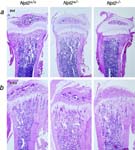Phenotypes associated with this allele
|
|
| Find Mice |
Using the International Mouse Strain Resource (IMSR)
Mouse lines carrying:
Slc34a1tm1Hten mutation
(1 available);
any
Slc34a1 mutation
(39 available)
|
|
|
growth/size/body
|
|
• significantly reduced body weight at birth
|
|
|
• significantly reduced body weight at 12 weeks of age
|
homeostasis/metabolism
renal/urinary system
|
|
• renal inorganic phosphate wasting
• improves with age
|
|
|
• mineral deposition in kidneys at 12 weeks of age
|
|
|
| Find Mice |
Using the International Mouse Strain Resource (IMSR)
Mouse lines carrying:
Slc34a1tm1Hten mutation
(1 available);
any
Slc34a1 mutation
(39 available)
|
|
|

Histological appearance of bone from wild-type, Slc34a1tm1Hten/Slc34a1+ and Slc34a1tm1Hten/Slc34a1tm1Hten mice
mortality/aging
|
|
• 44% of homozygotes die before or at weaning
• death is attributed to poor nutritional status
• homozygotes that survive weaning appear normal thereafter, despite smaller size and lower body weight
|
behavior/neurological
|
|
• homozygotes display some lethargy during the first 2 weeks of life
|
|
|
• homozygotes frequently have difficulties in feeding during the first 2 weeks of life
|
growth/size/body
|
|
• at birth, homozygotes are noticeably smaller than wild-type littermates
|
|
|
• at birth, homozygotes exhibit a significantly reduced body weight relative to wild-type controls (1.49 0.08 g vs 1.89 0.12 g)
|
|
|
• homozygotes remain significantly smaller than wild-type littermates for at least 4 months after birth
|
|
|
• homozygotes maintain a significantly lower body weight for at least 4 months after birth
|
homeostasis/metabolism
renal/urinary system
|
N |
• homozygotes show no evidence for amino aciduria, glycosuria, or proteinuria, indicating that the renal inorganic phosphate leak is not due to a generalized tubulopathy
|
|
|
• at 1 month of age, the urine calcium/creatinine ratio and the fractional excretion index for calcium (FEICa) are significantly increased
|
|
|
• at 1 month of age, the urine Pi/creatinine ratio and the fractional excretion index for Pi (FEIPi) are strikingly increased
|
skeleton
|
N |
• homozygotes do not exhibit rickets or osteomalacia
|
|
|
• poor initial development of cancellous bone
• by 45 days of age, the number metaphyseal trabeculae exceeded that in wild-type
|
|
|
• initial impairment of secondary ossification in the epiphysis observed at 21 days of age
• by 45 days of age, the skeletal phenotype had reversed and overcompensated
|
muscle
|
|
• homozygotes display apparent muscle weakness during the first 2 weeks of life
|
reproductive system
|
|
• homozygotes display reduced reproductive ability relative to wild-type and heterozygous controls
|
|
|
| Find Mice |
Using the International Mouse Strain Resource (IMSR)
Mouse lines carrying:
Slc34a1tm1Hten mutation
(1 available);
any
Slc34a1 mutation
(39 available)
Slc34a3tm1Kimi mutation
(0 available);
any
Slc34a3 mutation
(24 available)
|
|
|
growth/size/body
|
|
• marked growth retardation
|
homeostasis/metabolism
renal/urinary system
|
|
• abnormal phosphate re-uptake
|
|
|
• significantly elevated calcium levels in urine
|
|
|
• mineral deposition in kidneys
|
skeleton
|
|
• irregularly arranged metaphyseal trabecules
|
|
|
• deep growth plate cartilage
|
|
|
• reduced mineralization of trabecules
• significantly increased osteoid volume/bone volume
|
|
|
• develop typical features of rickets
• rescued by a high phosphate diet
|



 Analysis Tools
Analysis Tools